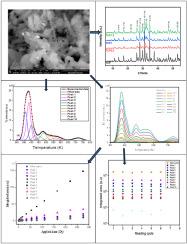镝掺杂浓度对磷酸三钙热释光性能的影响
IF 3.6
3区 物理与天体物理
Q2 OPTICS
引用次数: 0
摘要
以蜗牛壳为原料,采用可持续、环保的绿色合成方法,有效地合成了磷酸三钙。研究了镝(Dy)掺杂对TCP热释光特性的影响。x射线衍射(XRD)证实了其晶体结构,傅里叶变换红外光谱(FTIR)证实了TCP典型官能团的存在。研究了热释光性能,如剂量响应线性,可重复使用性和最小可检测剂量。在不同的Dy浓度中,1% Dy掺杂的TCP表现出最高的TL响应。分析了TCP辉光曲线的反褶积,发现有10个叠加的捕获峰。这些陷阱位于1.05 ~ 1.84 eV之间,并表现出0.11 ~ 275 Gy之间的线性剂量响应。制备样品的最小可检测剂量为350毫戈瑞。336小时后,在450-620 K温度范围内,衰减结果显示发光曲线强度没有变化。结果表明,dy掺杂TCP作为辐射剂量学应用的可行材料,特别是在医疗领域,精确和可靠的剂量评估至关重要。本文章由计算机程序翻译,如有差异,请以英文原文为准。

Impact of dysprosium doping concentration on the thermoluminescence properties of tricalcium phosphate
Tricalcium phosphate (TCP) was effectively synthesized from snail shells by a sustainable and eco-friendly green synthesis method. The impact of dysprosium (Dy) doping on TCP's thermoluminescence (TL) characteristics was carefully examined. X-ray diffraction (XRD) validated the crystalline structure, whilst Fourier-transform infrared spectroscopy (FTIR) substantiated the existence of the typical functional groups of TCP. The thermoluminescent properties were examined, like dose response linearity, reusability, and minimal detectable dosage. Among the different Dy concentrations, 1 % Dy-doped TCP displayed the highest TL response. The deconvolution of the TCP glow curves was analyzed to have 10 superimposed trapping peaks. These traps were located between 1.05 and 1.84 eV and exhibited a linear dose-response between 0.11 and 275 Gy. The minimum detectable dose of the prepared samples was 350 mGy. The fading results showed no change in the intensity of the glow curve in the temperature range of 450–620 K after 336 h. The results underscore Dy-doped TCP as a viable material for radiation dosimetry applications, especially in medical domains, where precise and dependable dosage evaluation is crucial.
求助全文
通过发布文献求助,成功后即可免费获取论文全文。
去求助
来源期刊

Journal of Luminescence
物理-光学
CiteScore
6.70
自引率
13.90%
发文量
850
审稿时长
3.8 months
期刊介绍:
The purpose of the Journal of Luminescence is to provide a means of communication between scientists in different disciplines who share a common interest in the electronic excited states of molecular, ionic and covalent systems, whether crystalline, amorphous, or liquid.
We invite original papers and reviews on such subjects as: exciton and polariton dynamics, dynamics of localized excited states, energy and charge transport in ordered and disordered systems, radiative and non-radiative recombination, relaxation processes, vibronic interactions in electronic excited states, photochemistry in condensed systems, excited state resonance, double resonance, spin dynamics, selective excitation spectroscopy, hole burning, coherent processes in excited states, (e.g. coherent optical transients, photon echoes, transient gratings), multiphoton processes, optical bistability, photochromism, and new techniques for the study of excited states. This list is not intended to be exhaustive. Papers in the traditional areas of optical spectroscopy (absorption, MCD, luminescence, Raman scattering) are welcome. Papers on applications (phosphors, scintillators, electro- and cathodo-luminescence, radiography, bioimaging, solar energy, energy conversion, etc.) are also welcome if they present results of scientific, rather than only technological interest. However, papers containing purely theoretical results, not related to phenomena in the excited states, as well as papers using luminescence spectroscopy to perform routine analytical chemistry or biochemistry procedures, are outside the scope of the journal. Some exceptions will be possible at the discretion of the editors.
 求助内容:
求助内容: 应助结果提醒方式:
应助结果提醒方式:


